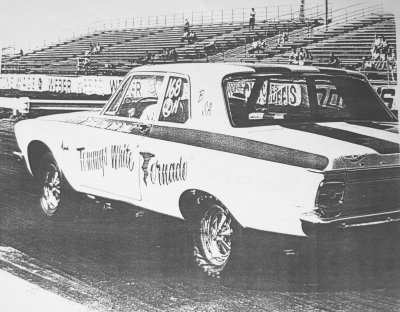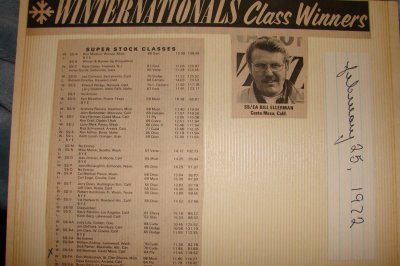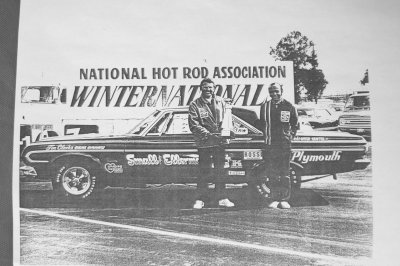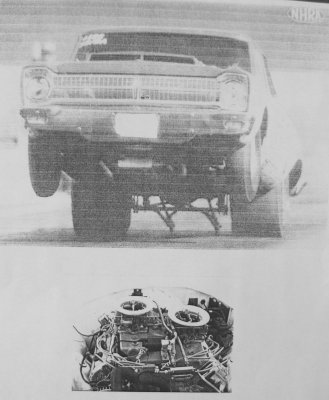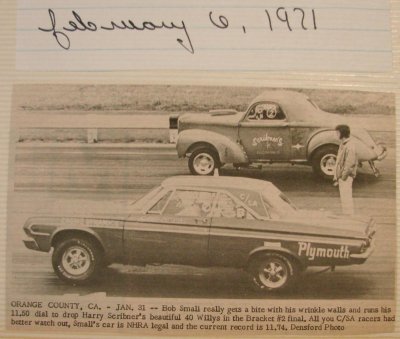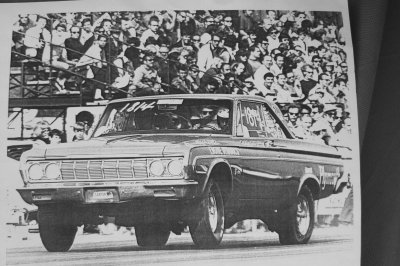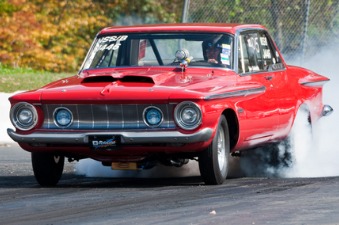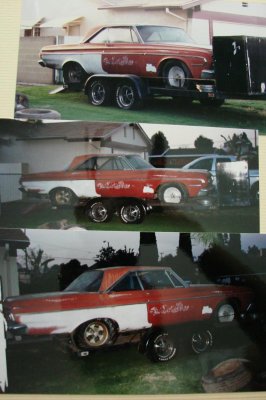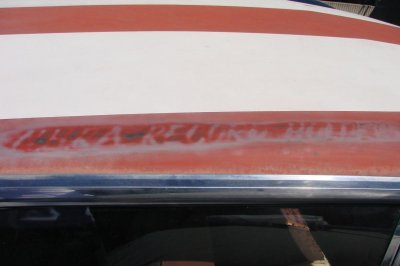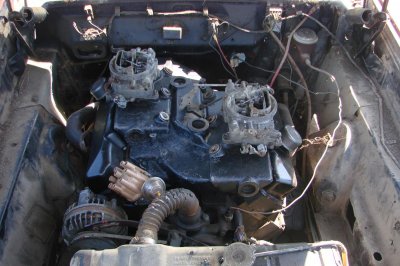earlyrides
Well-Known Member
This isn’t a story about a lucky S.O.B. who finds an unrestored max wedge racecar sitting on a trailer. This is a story about Bob Small, a guy in 1969 trying to live fast and die young after coming back from the war in Vietnam. It is also the story of a little old lady car that with a bit of help from Tom Hoover consistently beat up on the newer model Camaros and Mustangs much to the chagrin of the NHRA.
According to Bob Small: It all started in 1969. He was racing as a privateer in a 1963 max wedge called Tommys White Tornado.
He had just made a strong run and was wrenching under the car when a voice said, “Hey, you know where I can find Bob Small?”
“Sure. I’m him. Who wants to know?
Then the man said, “I’m Tom Hoover and I’d like to take you to lunch and talk to you about doing some racing for Chrysler.”
And that was the beginning of a short lived but very successful racing career.
It seems that Chrysler wanted to test some new developments in torque converter technology that had been the result of some R & D that they had been doing with B & M. They wanted Bob to run a 1964 Belvedere in Super Stock and were willing to give him some backing to do it.
In 1970, he procured a very unassuming 1964 Plymouth Belvedere Street Wedge 4-speed in Costa Mesa that was owned by the proverbial “little old lady”. They pulled the 426 Street Wedge / 4-speed combo and installed a Stage III Max Wedge / 727 and push buttons on the dash with parts provided by Chrysler. It ran well in C/SA with Bob at the wheel. As seen in this clipping from National Dragster from February 1971.
Bob realized early on that although he could build a solid performing car, his driving skills were not that great when it came to launching the car. According to Bob, “I would be up at the light and all I could think about was ignition timing, jetting, tire pressures and such. Then I would suddenly realize that the light had turned green and I had been daydreaming.”
It was then that he hired his friend, Bill Ellerman to drive the car. According to Bob, “Bill didn’t know that much about building engines, but he sure could cut a light!”
Midway through the 1971 season, Chrysler told Bob that they wanted to test a new torque converter in the car called a “Model J”. So they, (Chrysler) rented the entire Orange County Raceway for a day for the test. They took the car out with the 727 and standard converter for a baseline run. It ran a respectable 11.50 et. Then they changed out the converter for the model J. When they ran the car again it ran an amazing 11.20 et. When they saw the time slip, they all smiled because the current record in SS was 11.25 and they hadn’t even got all of the power to the ground!
From that point on it wasn’t so much about keeping up with the blue ovals and bowties but keeping up with the NHRA and their ever changing rules.
According to Bob: “We would win the event and set the national record and then be on a “high” going to the next event only to fail the tech inspection.” “Why?” we would protest.
“Because we caught you cheating.” The NHRA tech inspection would say.
“But we were legal last week?” Bob would say.
“Well, now there is a rule for that.” They would respond.
And so it went for the better part of 2 years. According to Bob, “the car ran great everywhere we took it. Even when the other guys would be suffering from heat, track conditions or altitude, the car ran solid.” Bob gives a lot of credit to the innovations to make the car go faster that he got from his friends at Chrysler and the fantastic driving by Bill Ellerman.
With all of the winning, sponsorships followed. Keystone wheels, Hooker, Carter, Engine Dynamics, Rossi transmissions all signed on to sponsor the car. It all paid off in 1971 when the car won its class at the winternationals as seen in this clipping from National Dragster from February 1971.
It then paid off again in 1972 when the car again won its class in Pomona and set the national record.
By now people were beginning to take note of the “privateer” team of Small & Ellerman. The other teams would complain to the NHRA that, “Small has parts on his car that are made from un-obtainium.” According to Bob: That’s when the tech official told us, “You Factory Chrysler boys can take your cars and leave right now; and we won’t care. The fans don’t want to see your old Belvedere. They want to see a new Camaro and a new Mustang run against each other in Super Stock.” So Bob unceremoniously told him,”Well; you just make those cars faster than my old Belvedere, and the fans will get to see them.”
In 1973, as a reward for all of his winning efforts, Chrysler gave Bob and Bill a 1965 Hemi Dart to step up to the highly competitive Pro Stock Class. Because of this heavy competition, they couldn’t achieve the success they enjoyed with the Maxie. The old Max Wedge, just a used racecar at the time, was sold to a local man, Ross Thomas. He had never been a drag racer, and really didn’t have a clue what kind of a machine he had bought. He also didn’t like the way the wheelie bars looked on the car, so he removed them. Needless to say, on one of his first outings he got the ride of his life as the Maxie pulled the front wheels high into the air. Panicking, he let off the throttle hard and slammed the car down onto the asphalt. He coasted through the lights and vowed never to drive the car again; which he never did. The car was placed on a trailer and stored in a garage and then in his backyard. There it stayed for over 30 years until it was taken off of the trailer by Mopar enthusiasts Vince and Jodi Lockyer in 2008.
Even in the Pro Stock class, the constant hounding of the Mopars though did not cease and after a short time, they quit racing altogether. Bob called all of his sponsors and told them how grateful he had been for their support and walked away from the sport he loved that had given him so much.
The next few years would be hard on Bob. As his bitterness grew about being forced out of drag racing by the well documented, lopsided NHRA rules meant to let the “other guys” win; according to Bob: He became an alcoholic. One day in the late 70s or early 80s in a drunken fit, Bob threw away everything that reminded him of his days as a drag racer. Into the trash went all of his photos, trophies, NHRA record certificates, sponsorship documents and racing gear; everything.
Another 15 years would pass before he could even talk about anything having to do with professional drag racing. He couldn’t even bring himself to go to an event or even watch it on TV. He eventually quit drinking and started a successful business building custom Harleys and specialty parts. His creations have been featured in several motorcycle magazines and sold for top dollar. His current works can be seen on his website, http://www.badassproductions.com .
According to Bob Small: It all started in 1969. He was racing as a privateer in a 1963 max wedge called Tommys White Tornado.
He had just made a strong run and was wrenching under the car when a voice said, “Hey, you know where I can find Bob Small?”
“Sure. I’m him. Who wants to know?
Then the man said, “I’m Tom Hoover and I’d like to take you to lunch and talk to you about doing some racing for Chrysler.”
And that was the beginning of a short lived but very successful racing career.
It seems that Chrysler wanted to test some new developments in torque converter technology that had been the result of some R & D that they had been doing with B & M. They wanted Bob to run a 1964 Belvedere in Super Stock and were willing to give him some backing to do it.
In 1970, he procured a very unassuming 1964 Plymouth Belvedere Street Wedge 4-speed in Costa Mesa that was owned by the proverbial “little old lady”. They pulled the 426 Street Wedge / 4-speed combo and installed a Stage III Max Wedge / 727 and push buttons on the dash with parts provided by Chrysler. It ran well in C/SA with Bob at the wheel. As seen in this clipping from National Dragster from February 1971.
Bob realized early on that although he could build a solid performing car, his driving skills were not that great when it came to launching the car. According to Bob, “I would be up at the light and all I could think about was ignition timing, jetting, tire pressures and such. Then I would suddenly realize that the light had turned green and I had been daydreaming.”
It was then that he hired his friend, Bill Ellerman to drive the car. According to Bob, “Bill didn’t know that much about building engines, but he sure could cut a light!”
Midway through the 1971 season, Chrysler told Bob that they wanted to test a new torque converter in the car called a “Model J”. So they, (Chrysler) rented the entire Orange County Raceway for a day for the test. They took the car out with the 727 and standard converter for a baseline run. It ran a respectable 11.50 et. Then they changed out the converter for the model J. When they ran the car again it ran an amazing 11.20 et. When they saw the time slip, they all smiled because the current record in SS was 11.25 and they hadn’t even got all of the power to the ground!
From that point on it wasn’t so much about keeping up with the blue ovals and bowties but keeping up with the NHRA and their ever changing rules.
According to Bob: “We would win the event and set the national record and then be on a “high” going to the next event only to fail the tech inspection.” “Why?” we would protest.
“Because we caught you cheating.” The NHRA tech inspection would say.
“But we were legal last week?” Bob would say.
“Well, now there is a rule for that.” They would respond.
And so it went for the better part of 2 years. According to Bob, “the car ran great everywhere we took it. Even when the other guys would be suffering from heat, track conditions or altitude, the car ran solid.” Bob gives a lot of credit to the innovations to make the car go faster that he got from his friends at Chrysler and the fantastic driving by Bill Ellerman.
With all of the winning, sponsorships followed. Keystone wheels, Hooker, Carter, Engine Dynamics, Rossi transmissions all signed on to sponsor the car. It all paid off in 1971 when the car won its class at the winternationals as seen in this clipping from National Dragster from February 1971.
It then paid off again in 1972 when the car again won its class in Pomona and set the national record.
By now people were beginning to take note of the “privateer” team of Small & Ellerman. The other teams would complain to the NHRA that, “Small has parts on his car that are made from un-obtainium.” According to Bob: That’s when the tech official told us, “You Factory Chrysler boys can take your cars and leave right now; and we won’t care. The fans don’t want to see your old Belvedere. They want to see a new Camaro and a new Mustang run against each other in Super Stock.” So Bob unceremoniously told him,”Well; you just make those cars faster than my old Belvedere, and the fans will get to see them.”
In 1973, as a reward for all of his winning efforts, Chrysler gave Bob and Bill a 1965 Hemi Dart to step up to the highly competitive Pro Stock Class. Because of this heavy competition, they couldn’t achieve the success they enjoyed with the Maxie. The old Max Wedge, just a used racecar at the time, was sold to a local man, Ross Thomas. He had never been a drag racer, and really didn’t have a clue what kind of a machine he had bought. He also didn’t like the way the wheelie bars looked on the car, so he removed them. Needless to say, on one of his first outings he got the ride of his life as the Maxie pulled the front wheels high into the air. Panicking, he let off the throttle hard and slammed the car down onto the asphalt. He coasted through the lights and vowed never to drive the car again; which he never did. The car was placed on a trailer and stored in a garage and then in his backyard. There it stayed for over 30 years until it was taken off of the trailer by Mopar enthusiasts Vince and Jodi Lockyer in 2008.
Even in the Pro Stock class, the constant hounding of the Mopars though did not cease and after a short time, they quit racing altogether. Bob called all of his sponsors and told them how grateful he had been for their support and walked away from the sport he loved that had given him so much.
The next few years would be hard on Bob. As his bitterness grew about being forced out of drag racing by the well documented, lopsided NHRA rules meant to let the “other guys” win; according to Bob: He became an alcoholic. One day in the late 70s or early 80s in a drunken fit, Bob threw away everything that reminded him of his days as a drag racer. Into the trash went all of his photos, trophies, NHRA record certificates, sponsorship documents and racing gear; everything.
Another 15 years would pass before he could even talk about anything having to do with professional drag racing. He couldn’t even bring himself to go to an event or even watch it on TV. He eventually quit drinking and started a successful business building custom Harleys and specialty parts. His creations have been featured in several motorcycle magazines and sold for top dollar. His current works can be seen on his website, http://www.badassproductions.com .

